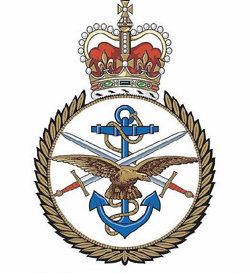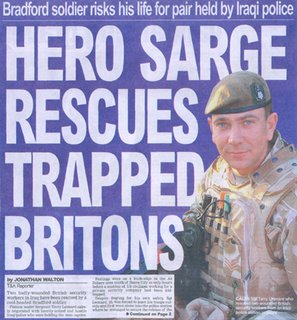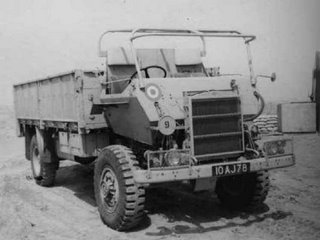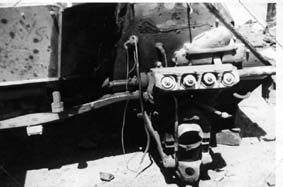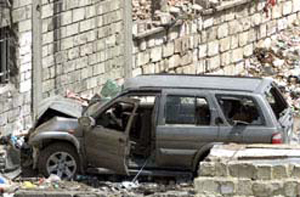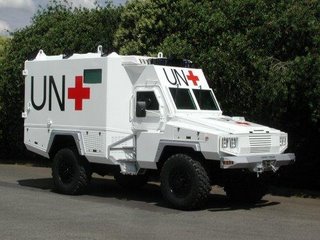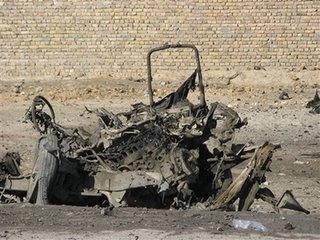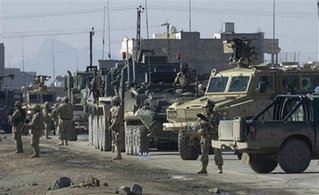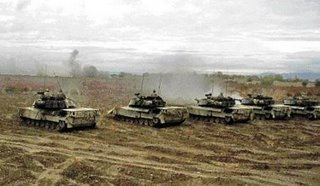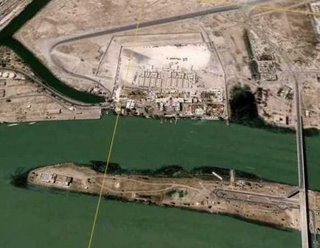 With the coroner's report on Sergeant Steve Roberts's death just out, for a brief moment, lack of Army equipment is in the news. Roberts was the soldier who, for want of body armour, was killed in a "friendly fire" incident on 24 March 2003, as he manned a checkpoint outside the southern Iraqi city of Az Zubayr.
With the coroner's report on Sergeant Steve Roberts's death just out, for a brief moment, lack of Army equipment is in the news. Roberts was the soldier who, for want of body armour, was killed in a "friendly fire" incident on 24 March 2003, as he manned a checkpoint outside the southern Iraqi city of Az Zubayr.But this issue has been smouldering in the background for a long time, largely ignored by the politicians and the media. The former seem more interested in exploiting the military for their "photo opportunities" while the latter seem to treat military affairs as a source of cheap copy. Neither seem to be devoting any time or energy to ensuring that our armed forces are properly equipped.
In this context, the "real" war - i.e., the one the politicians are most interested in - is the battle for the photo-op. For instance, when David Cameron visited the troops in Basra, the government made sure there were no photographs of him addressing soldiers. The few that were published, well after the event, in the main showed the Tory leader talking to (or at) senior officers.
On the other hand, within hours of the great leader Tony's flying visit to Basra Air Station yesterday, we had dozens of photographs to chose from, ranging from the formal address, to the casual and informal, and the "touching", with Blair writing a good luck message on a Warrior MICV.
 This cannot, just cannot be a coincidence. I have absolutely no doubt that private polling by the political parties (which produce the detailed results, the like of which we do not see) show that politicians who are seen associating with the military score well in the polls. Hence the succession of Labour ministers making their pilgrimages to both Afghanistan and Iraq, the ready accessibility of the photographs taken and the lengths to which the government goes to ensure that Conservative politicians do not have the same facility.
This cannot, just cannot be a coincidence. I have absolutely no doubt that private polling by the political parties (which produce the detailed results, the like of which we do not see) show that politicians who are seen associating with the military score well in the polls. Hence the succession of Labour ministers making their pilgrimages to both Afghanistan and Iraq, the ready accessibility of the photographs taken and the lengths to which the government goes to ensure that Conservative politicians do not have the same facility.What we may be seeing – and in my view almost certainly are seeing – is an attempt to capitalise on reflected glory - and, in the context of continued and massive shortages of equipment - doing it on the cheap. For sure, political sophisticates can see through this, but adverse comment has a limited circulation and a short shelf-life. The subliminal message conveyed by a picture of Blair surrounded by "admiring" troops has, I would suggest, a more widespread and lasting effect, which drowns out the cynicism. And, if Balir can get this without coughing up the money for the kit, what should he change?
 Similarly, I remain suspicious of the torrent of medals being awarded to troops in the field, something to which I drew attention in an earlier piece, noting the parallel between this government the last days of the siege of Stalingrad, when Junkers 52s from Hitler's Luftwaffe were dispatched to airdrop container-loads of Iron Crosses to the beleaguered troops of the 6th Army.
Similarly, I remain suspicious of the torrent of medals being awarded to troops in the field, something to which I drew attention in an earlier piece, noting the parallel between this government the last days of the siege of Stalingrad, when Junkers 52s from Hitler's Luftwaffe were dispatched to airdrop container-loads of Iron Crosses to the beleaguered troops of the 6th Army.That, as I wrote at the time, is not in any way to disparage the bravery of our troops, and particularly the likes of Cpl. Bryan Budd, VC, about whom Joe Katzman wrote a moving tribute on his Winds of Change blog.
But, to this old cynic, to find his story recounted in detail on the MoD site - the output of an intensely political government ministry – somehow jars. How convenient it is to have such tales of derring-do which cannot help but invoke positive feelings – with some of the glory inescapably rubbing off on the Ministry. And how much cheaper it is to buy off the troops with medals rather than equip them properly.
 It is the same with the tragic deaths of service personnel in theatre - often the result of equipment shortages or inadequacies. Note, for instance, the careful attention to detail following the deaths arising from the bomb on the Shatt al-Arab, the emotive personal pictures and the carefully staged photographs of the repatriation of their bodies.
It is the same with the tragic deaths of service personnel in theatre - often the result of equipment shortages or inadequacies. Note, for instance, the careful attention to detail following the deaths arising from the bomb on the Shatt al-Arab, the emotive personal pictures and the carefully staged photographs of the repatriation of their bodies.All right and proper you might say and you would have to have a heart of stone not to be moved by the details. But, as we recorded on this blog, how selective were those details. And, even to this day, further details have to be dragged out of the MoD, viz the answer to another written parliamentary question from the dogged Mike Hancock MP, who has asked how many incidents of British service personnel coming under attack on the Shatt al-Arab waterway took place before the 12 November bombing.
The answer came again from bully-boy Ingram, which stated: "Centrally held records show that between 15 June 2003 and 23 November 2006 there have been 16 attacks on British forces transiting the Shatt al-Arab waterway". Note the use of "centrally held records", which means there were almost certainly more than 16 attacks which suggests that – as we have indicated – that there was an extremely high risk of a fatal incident.
You will, of course, note no reference to this question on the MoD website, nor will you see any of the information conveyed on that website. And such selectivity suggests that the MoD is exploiting the courage and suffering of its "employees" while being highly economical about the circumstances in which they occurred.
By that measure, perhaps personal details relating to service personnel should not appear on the MoD site but on the respective sites maintained by each service, with a degree of detachment from the MoD.
The trouble is though that you will not get support from the media for such a quest. Journalists appreciate the quickness and convenience of the one-stop-shop and are, in any case, in the exploitative business themselves, capitalising on what is actually cheap copy. Thus you get the saturation coverage in the Telegraph and in the manner of this newspaper, which is so quick to defend its own intellectual property, there is not a whisper of a suggestion that its source was MoD press handouts, its coverage being merely edits of the free copy provided.
 But a particularly odious player in the exploitation game is Mike Smith of The Times, who uses the courage (and the death) of Corporal Bryan Budd (pictured) as a foil to make a series of points in his own blog, the post headed – with the lack of imagination for which the man is famous – "Lions Led By Whitehall Donkeys".
But a particularly odious player in the exploitation game is Mike Smith of The Times, who uses the courage (and the death) of Corporal Bryan Budd (pictured) as a foil to make a series of points in his own blog, the post headed – with the lack of imagination for which the man is famous – "Lions Led By Whitehall Donkeys".He writes (again without acknowledging his sources) of the failure of the RAF to deliver supplies to the troops holed up in Sangin, due in part to the unserviceability of the Hercules tasked to support them and then to a drop missing its target, supplies falling into the centre of the town in a mosque controlled by the Taliban.
He describes how the US stepped in with their helicopters, to deliver rations and how further supplies were delivered by a Canadian relief convoy, "making a mockery of government claims that the British had enough troops and resources of their own." And then, as 3rd Para soldiers repulsed the Taliban again and again, Smith writes:
By now the Taliban were reluctant to make direct attacks and concentrated on rocket and mortar attacks, one of which killed L/Cpl Luke McCulloch of the Royal Irish Regiment, a week into the deployment. He was the eighth British soldier to die in Sangin.What makes the difference between this and, say, the purely descriptive pieces in the Telegraph and the measured piece by Katzman it that Smith uses the detail to snipe at the government – but he does not use his power to fight for better equipment.
 In fact, this is the man who swallowed the MoD propaganda on "Snatch" Land Rovers, and buys in uncritically to the idea of armoured Pinzgauers.
In fact, this is the man who swallowed the MoD propaganda on "Snatch" Land Rovers, and buys in uncritically to the idea of armoured Pinzgauers.Inevitably, therefore, as he writes about L/Cpl Luke McCulloch being killed in one of the many rocket and mortar attacks, he does not think to ask why the British Army in this day and age is so vulnerable to such primitive weapons, why it is not taking countermeasures and why technology which has been available for decades is not being used.
This is where editorialising over the unfortunate death of Sergeant Steve Roberts can actually be harmful.
 It is all very well tut-tutting about the lack of kit in 2003, but the MoD has since made heroic efforts to ensure that all troops in operation areas are equipped with the very latest in body armour. This, therefore, is no longer an issue and, in the final analysis, it was only (partially) responsible for the death of one man. Many more have been killed through inadequate vehicles and through failing to deal with the mortar menace.
It is all very well tut-tutting about the lack of kit in 2003, but the MoD has since made heroic efforts to ensure that all troops in operation areas are equipped with the very latest in body armour. This, therefore, is no longer an issue and, in the final analysis, it was only (partially) responsible for the death of one man. Many more have been killed through inadequate vehicles and through failing to deal with the mortar menace.Roberts's widow Samantha herself noted that the body armour issue had been resolved. "This is Steve's legacy," she said. Referring to MoD supply failures, she added, "but we must ensure that these failures are not repeated with other basic kit."
Just focusing on body armour, therefore, will simply allow the MoD to wriggle off the hook, evading scrutiny for the serious shortage of kit, which is now current, such as the Vipir thermal imager, UAV's, light helicopters and much else.
Typically though one can see the media going for the cheap and easy option, exploiting others' grief and misfortune, but not seeking to prevent more of it. Then, in giving the impression of "supporting our boys", it is also going for the reflected glory. In that way, the media are as bad as the politicians.
What we actually need from both the media and the politicians is clear, clinical detail on what our troops need and then active campaigns to ensure that they get it. This is where the opposition should be up front and making itself heard. Moralising and pontificating about issues long past - or merely uttering generalised waffle - is not good enough.
 All we are hearing from Tory defence spokesman Liam Fox is the view that: "To send soldiers into combat without the appropriate equipment is utterly inexcusable and in a more honourable government it would have resulted in resignations. The story of this government's defence policy is too little, too late."
All we are hearing from Tory defence spokesman Liam Fox is the view that: "To send soldiers into combat without the appropriate equipment is utterly inexcusable and in a more honourable government it would have resulted in resignations. The story of this government's defence policy is too little, too late."He adds that, "We still hear stories which reinforce the point that Tony Blair's government is all too willing to commit our forces to battle without committing the appropriate resources to our armed forces."
That certainly is not good enough. What is he going to do about it?

